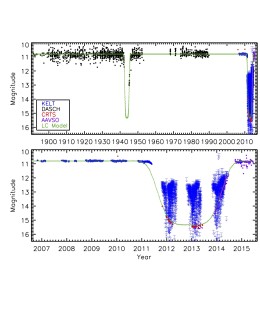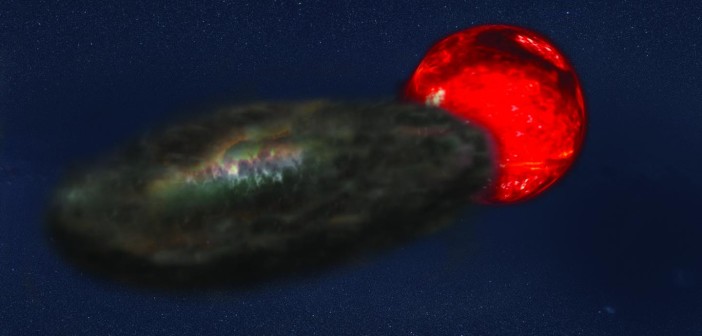A new record holder exists for the longest-period eclipsing binary star system: TYC-2505-672-1. This intriguing system contains a primary star that is eclipsed by its companion once every 69 years — with each eclipse lasting several years!
120 Years of Observations
In a recent study, a team of scientists led by Joseph Rodriguez (Vanderbilt University) characterizes the components of TYC-2505-672-1. This binary star system consists of an M-type red giant star that undergoes a ~3.45-year-long, near-total eclipse with a period of ~69.1 years. This period is more than double that of the previous longest-period eclipsing binary!
Rodriguez and collaborators combined photometric observations of TYC-2505-672-1 by the Kilodegree Extremely Little Telescope (KELT) with a variety of archival data, including observations by the American Association of Variable Star Observers (AAVSO) network and historical data from the Digital Access to a Sky Century @ Harvard (DASCH) program.
In the 120 years spanned by these observations, two eclipses are detected: one in 1942-1945 and one in 2011-2015. The authors use the observations to analyze the components of the system and attempt to better understand what causes its unusual light curve.
Characterizing an Unusual System

Observations of TYC-2505-672-1 plotted from 1890 to 2015 reveal two eclipses. (The blue KELT observations during the eclipse show upper limits only.) [Rodriguez et al. 2016]
The authors argue that the best model of TYC-2505-672-1 is one in which the small companion star is surrounded by a large, opaque circumstellar disk. Rodriguez and collaborators suggest that the companion could be a former red giant whose atmosphere was stripped from it, leaving behind the small, hot core shrouded by a large, cool disk of stripped gas. The large size of the disk causes the eclipse of the primary to last for years, as viewed from Earth.
The authors estimate the properties such a disk would need to produce the observed light curve. They find that if the companion were surrounded by a disk several AU in diameter, it could orbit at a distance of ~20-30 AU from the primary and reproduce the emission we see.
The next eclipse of TYC-2505-672-1 will begin in April 2080. We needn’t wait until then to gather more information about this system, however! Radial velocity measurements will help establish the masses of the two components, and high-cadence UV observations could reveal more about the evolutionary state of the system. Studying this extreme binary provides an excellent opportunity to learn more about the environments in late-life star systems.
Citation
Joseph E. Rodriguez et al 2016 AJ 151 123. doi:10.3847/0004-6256/151/5/123

1 Comment
Pingback: competition for epsilon Aurigae